June 18, 2025 | 10:13 GMT +7
June 18, 2025 | 10:13 GMT +7
Hotline: 0913.378.918
June 18, 2025 | 10:13 GMT +7
Hotline: 0913.378.918
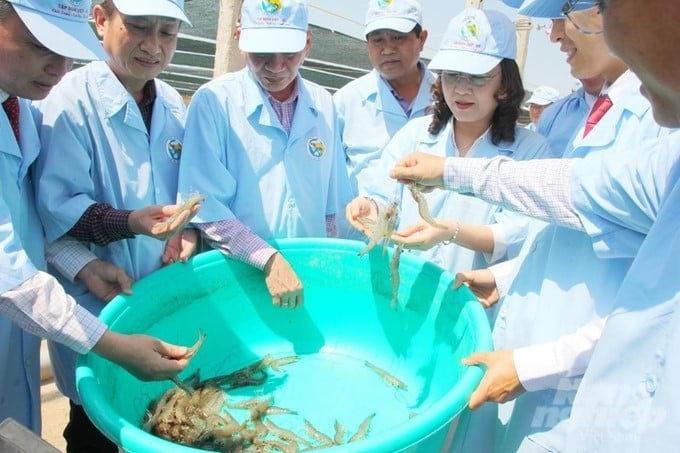
Bac Lieu province is the center of the country's shrimp industry. Photo: Trong Linh.
With signature ecological conditions, Bac Lieu province has been focusing on restructuring agricultural production in the direction of proactive adaptation. If drought and salinity are identified as risks, Bac Lieu has transformed risks into opportunities. In particular, rice-shrimp production is a smart model for adapting to climate change.
Bac Lieu is known as the center of the country’s shrimp industry. Of which, in addition to the model of super-intensive shrimp farming with high-tech applications, Bac Lieu also has many other unique models of natural shrimp farming, such as the shrimp-forest model and the shrimp-rice model.
Experts in the field of agriculture call the rice-shrimp model a smart production model because it is a sustainable model that can adapt to climate change. Its uniqueness is the "combination" between rice and shrimp in a land area where only weedy rice, also known as seasonal rice in the past, could survive.

The rice-shrimp model solves the problem of adapting to climate change effectively and sustainably. Photo: Trong Linh.
In the early 2000s, Bac Lieu province converted production from inefficient rice farming to shrimp farming. With shrimp living on rice land, the rice monoculture that could only grow one crop per year was broken and replaced by two shrimp crops and one rice crop per year. Since then, rice has been made "more beautiful" with a series of new rice varieties in saline areas, giving a yield of approximately 7 tons/ha (compared to only 3 - 4 tons/ha as before).
The effect of the rice-shrimp model has made the production areas of localities in the north of National Highway 1A change their look with a brilliant new appearance. Many houses, buildings, traffic routes, and irrigation infrastructure are constantly being expanded to serve the agricultural production industry, which is considered a strength in the economic development of Bac Lieu province.
Small production models have developed into large specialized farming areas of commodity production according to the large field model. If the area of the rice-shrimp model was only about 5,800ha in 2001, it had increased to approximately 40,000 ha by 2021, accounting for 34% of the total shrimp farming area in the province, and it has now exceeded 40,000 ha.
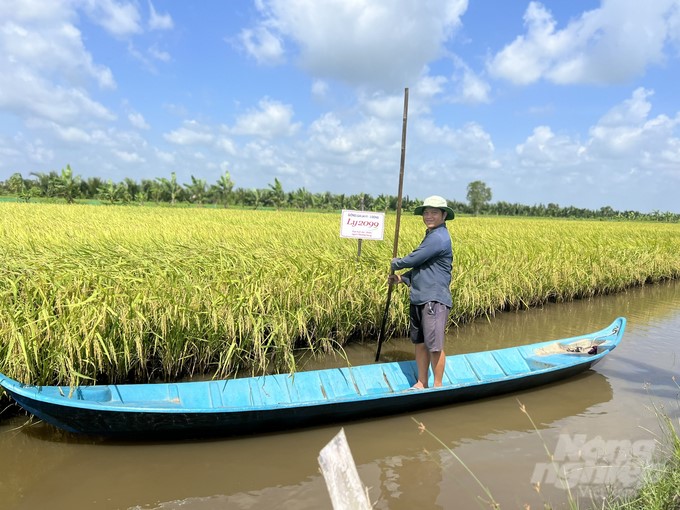
Many new rice varieties are adapted to the natural environment in the rice-shrimp production areas of Bac Lieu. Photo: Trong Linh.
One of the reasons for the rice-shrimp production model to develop quickly and be applied by many farmers is the smart adaptation and practical benefits it brings. The advantage of the rice-shrimp model is the variety of products. In addition to the main products, including giant tiger prawn, giant freshwater prawn, and rice seeds, the model can also take advantage of resources to intercrop other crops and aquatic products sustainably, helping farmers increase their income, such as the rice-shrimp model combined with freshwater fish farming or the model of growing subsidiary crops on the shrimp square bank.
Another advantage is that the rice-shrimp farming system is very environmentally friendly, easy to apply integrated management solutions to, reduces the need to use chemicals in rice production, and causes less harm to the natural environment, making it suitable for the requirements of good agricultural production practices (GAP) and organic production.
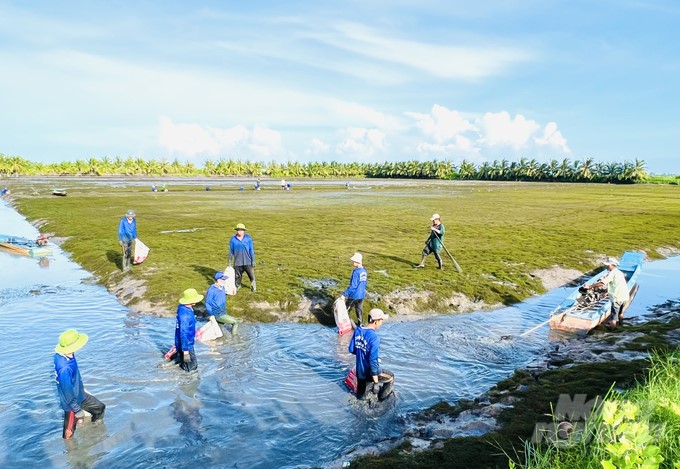
Farmers in Hong Dan district (Bac Lieu) harvest giant freshwater prawns. Photo: Trong Linh.
The rice-shrimp model can also promote the positive factors of shrimp and rice, such as helping to improve soil, eliminating pests, and cutting off the life cycle of pests during growth and development. After a shrimp crop, the wastes are metabolized and absorbed by rice, contributing to limiting the amount of fertilizer and pesticide in the early stages.
And after a rice crop, all kinds of rice straw and paddy dropped from the rice plants left in the field after harvest are decomposed, creating a living environment and a natural source of nutritious food for shrimp in the next farming season. Thereby, it is not necessary for farmers to invest money to buy food for shrimp, like in the industrial shrimp farming model. As a result, this model contributes to reducing production and investment costs and increasing productivity and profits.
Translated by Huyen Vu Thu
/2025/06/17/3942-2-143243_548.jpg)
(VAN) Recently, in Sweden, the Secretary of the Binh Dinh Provincial Party Committee presented the Investment Registration Certificate for the 'Polyester Fabric Recycling Complex' project to SYRE Impact-AB Company.
/2025/06/12/3721-2-202745_83.jpg)
(VAN) TH made an impression at Seoul Food 2025 with its line of natural beverages, paving the way for Vietnamese food products to enter the South Korean market.
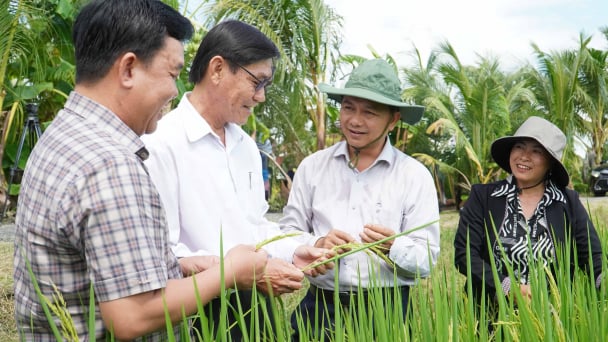
(VAN) Soc Trang's success in rice exports stems from a strategy of developing fragrant and specialty rice cultivation areas and standardizing production toward low-emission practices.
/2025/06/11/1311-5-120811_839.jpg)
(VAN) The pig farming industry is facing the challenge of comprehensive restructuring to meet requirements for quality, safety, traceability, and market expansion both domestically and for export.
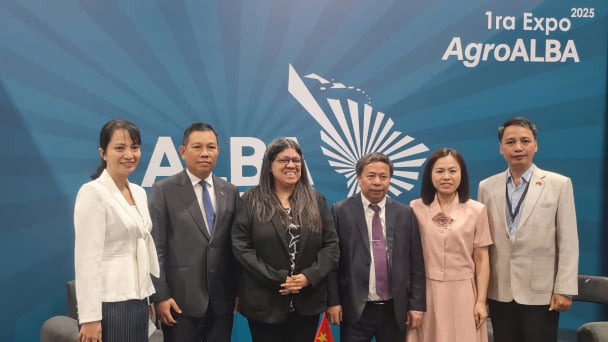
(VAN) Vietnam considers participating in ALGROALBA in order to expand agricultural production, coordinate the assessment and effective exploitation potential land.
/2025/06/05/5314-1-184727_407.jpg)
(VAN) From seemingly worthless fish scales and skin, enzymes and lactic ferments can transform by-products into peptides, opening a sustainable, effective business direction and elevating Vietnamese seafood.
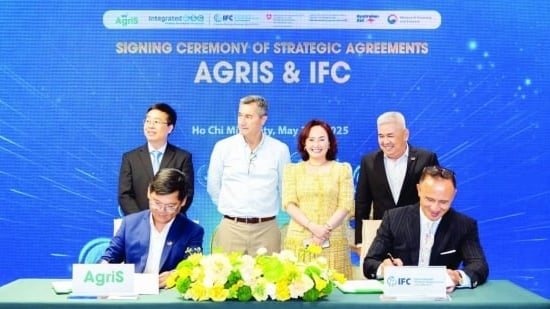
(VAN) TTC AgriS and IFC signed a strategic partnership to develop a sustainable agricultural value chain, aiming to achieve the Net Zero target by 2035.